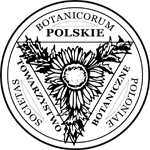Phytopythium leanoi sp. nov. and Phytopythium dogmae sp. nov., Phytopythium species associated with mangrove leaf litter from the Philippines
Abstract
Keywords
Full Text:
PDFReferences
Thines M. Phylogeny and evolution of plant pathogenic oomycetes – a global overview. Eur J Plant Pathol. 2014;138:431–447. https://doi.org/10.1007/s10658-013-0366-5
Bala K, Robideau GP, Lévesque CA, de Cock AWAM, Abad ZG, Lodhi AM, et al. Phytopythium Abad, de Cock, Bala, Robideau, Lodhi and Lévesque, gen. nov. and Phytopythium sindhum Lodhi, Shahzad, and Lévesque, sp. nov. Persoonia. 2010;24:136–137. https://doi.org/10.3767/003158510X512748
Hulvey J, Telle S, Nigrelli L, Lamour K, Thines M. Salisapiliaceae – a new family of oomycetes from marsh grass litter of southeastern North America. Persoonia. 2010;25:109–116. https://doi.org/10.3767/003158510X551763
Lara E, Belbahri L. SSU rRNA reveals major trends in oomycete evolution. Fungal Divers. 2011;49:93–100. https://doi.org/10.1007/s13225-011-0098-9
Villa NO, Kageyama K, Asano T, Suga H. Phylogenetic relationship of Pythium and Phytophthora species based on ITS rDNA, cytochrome oxidase II and β-tubulin gene sequences. Mycologia. 2006;98:410–422. https://doi.org/10.1080/15572536.2006.11832676
Spies CF, Grooters AM, Lévesque CA, Rintoul TL, Redhead SA, Glockling SL, et al. Molecular phylogeny and taxonomy of Lagenidium-like oomycetes pathogenic to mammals. Fungal Biol. 2016;120:931–947. https://doi.org/10.1016/j.funbio.2016.05.005
Uzuhashi S, Tojo M, Kakishima M. Phylogeny of the genus Pythium and description of new genera. Mycoscience. 2010;51:337–365. https://doi.org/10.1007/s10267-010-0046-7
Beakes GW, Honda D, Thines M. Systematics of the Straminipila: Labyrinthulomycota, Hyphochytriomycota, and Oomycota. In: McLaughlin DJ, Spatafora JW, editors. Systematics and evolution. Berlin: Springer; 2014. p. 39–97. (Mycota; vol 7A). https://doi.org/10.1007/978-3-642-55318-9_3
Lévesque CA, de Cock AWAM. Molecular phylogeny and taxonomy of the genus Pythium. Mycol Res. 2004;108:1363–1383. https://doi.org/10.1017/S0953756204001431
Leaño EM. Straminipilous organisms from fallen mangrove leaves from Panay Island, Philippines. Fungal Divers. 2001;6:75–81.
Jesus AL, Marano AV, Jerônimo GH, De Souza JI, Leaño EM, Pires-Zottarelli CLA. The genus Halophytophthora (Peronosporales, Straminipila) in Brazil: first descriptions of species. Rev Bras Bot. 2016;39:729–739. https://doi.org/10.1007/s40415-016-0257-z
Bennett RM, Thines M. Confirmation that Phytophthora insolita (Peronosporaceae) is present as a marine saprotroph on mangrove leaves and first report of the species for the Philippines. Nova Hedwigia. 2017;105:185–196. https://doi.org/10.1127/nova_hedwigia/2017/0404
Crous PW, Verkley GJM, Groenewald JZ, Ramson RA. Fungal biodiversity. Utrecht: CBS-KNAW Fungal Biodiversity Centre; 2009. (CBS Laboratory Manual Series).
Solis MJL, Draeger S, Dela Cruz TEE. Marine-derived fungi from Kappaphycus alvarezii and K. striatum as potential causative agents of ice-ice disease in farmed seaweeds. Botanica Marina. 2010;53:587–594. https://doi.org/10.1515/bot.2010.071
Katoh K, Misawa K, Kuma K, Miyata T. MAFFT: a novel method for rapid multiple sequence alignment based on fast Fourier transform. Nucleic Acids Res. 2002;30:3059–3066. https://doi.org/10.1093/nar/gkf436
Price MN, Dehal PS, Arkin AP. FastTree: computing large minimum-evolution trees with profiles instead of a distance matrix. Mol Biol Evol. 2009;26:1641–1650. https://doi.org/10.1093/molbev/msp077
Stamatakis A. RAxML version 8: a tool for phylogenetic analysis and post-analysis of large phylogenies. Bioinformatics. 2014;30:1312–1313. https://doi.org/10.1093/bioinformatics/btu033
Ronquist F, Teslenko M, van der Mark P, Ayres DL, Darling A, Höhna S, et al. MrBayes 3.2: efficient Bayesian phylogenetic inference and model choice across a large model space. Syst Biol. 2012;61:539–542. https://doi.org/10.1093/sysbio/sys029
Tamura K, Stecher G, Peterson D, Filipski A, Kumar S. MEGA6: Molecular Evolutionary Genetics Analysis Version 6.0. Mol Biol Evol. 2013;30:2725–2729. https://doi.org/10.1093/molbev/mst197
de Cock AWAM, Lodhi AM, Rintoul TL, Bala K, Robideau GP, Abad ZG, et al. Phytopythium: molecular phylogeny and systematics. Persoonia. 2015;34:25–39. https://doi.org/10.3767/003158515X685382
Marano AV, Jesus AL, de Souza JI, Leaño EM, James TY, Jerônimo GH, et al. A new combination in Phytopythium: P. kandeliae (Oomycetes, Straminipila). Mycosphere. 2014;5:510–522. https://doi.org/10.5943/mycosphere/5/4/3
Ho HH, Chang HS, Hsieh SY. Halophytophthora kandeliae, a new marine fungus from Taiwan. Mycologia. 1991;83:419–424. https://doi.org/10.2307/3760352
Baten MA, Asano T, Motohashi K, Ishiguro Y, Rahman MZ, Inaba S, et al. Phylogenetic relationships among Phytopythium species, and re-evaluation of Phytopythium fagopyri comb. nov., recovered from damped-off buckwheat seedlings in Japan. Mycol Prog. 2014;13:1145–1156. https://doi.org/10.1007/s11557-014-1003-1
Jesus AL, Gonçalves DR, Rocha SCO, Marano AV, Jerônimo GH, de Souza JI, et al. Morphological and phylogenetic analyses of three Phytopythium species (Peronosporales, Oomycota) from Brazil. Cryptogamie, Mycologie. 2016;37:117–128. https://doi.org/10.7872/crym/v37.iss1.2016.117
Bennett RM, de Cock AWAM, Lévesque CA, Thines M. Calycofera gen. nov., an estuarine sister taxon to Phytopythium, Peronosporaceae. Mycol Prog. 2017;16:947–954. https://doi.org/10.1007/s11557-017-1326-9
Bachofer M. Molekularbiologische populationsstudien an Plasmopara halstedii, dem falschen mehltau der sonnenblume [PhD thesis]. Stuttgart: University of Hohenheim; 2004.
Moncalvo JM, Wang HH, Hseu RS. Phylogenetic relationships in Ganoderma inferred from the internal transcribed spacers and 25S ribosomal DNA sequences. Mycologia. 1995;87:223–238. https://doi.org/10.2307/3760908
Riethmüller A, Voglmayer H, Göcker M, Weiß M, Oberwinkler F. Phylogenetic relationships of the downy mildews (Peronosporales) and related groups based on nuclear large ribosomal DNA sequences. Mycologia. 2001;94:834–849. https://doi.org/10.1080/15572536.2003.11833177
Robideau GP, de Cock AWAM, Coffey MD, Voglmayr H, Brouwer H, Bala K, et al. DNA barcoding of oomycetes with cytochrome c oxidase I and internal transcribed spaces. Mol Ecol Resour. 2011;11:1002–1011. https://doi.org/10.1111/j.1755-0998.2011.03041.x
Hudspeth DSS, Nadler SA, Hudspeth MES. A COX2 molecular phylogeny of the Peronosporomycetes. Mycologia. 2000;92:674–684. https://doi.org/10.2307/3761425
Choi YJ, Beakes G, Glockling S, Kruse J, Nam B, Nigrelli L, et al. Towards a universal barcode of oomycetes – a comparison of the cox1 and cox2 loci. Mol Ecol Resour. 2015;15:1275–1288. https://doi.org/10.1111/1755-0998.12398
Chen XR, Liu BB, Xing YP, Cheng BP, Liu ML, Tong YH, et al. Identification and characterization of Phytopythium helicoides causing stem rot of Shatangju mandarin seedlings in China. Eur J Plant Pathol. 2016;146:715–727. https://doi.org/10.1007/s10658-016-0952-4
Sideris CP. Taxonomic studies in the family Pythiaceae II. Pythium. Mycologia. 1932;24:14–61. https://doi.org/10.2307/3753729
van der Plaats-Niterink AJ. Monograph of the genus Pythium. Stud Mycol. 1981;21:1–242.
Drechsler C. Some new species of Pythium. J Wash Acad Sci. 1930;20:399–418.
DOI: https://doi.org/10.5586/am.1103
|
|
|






